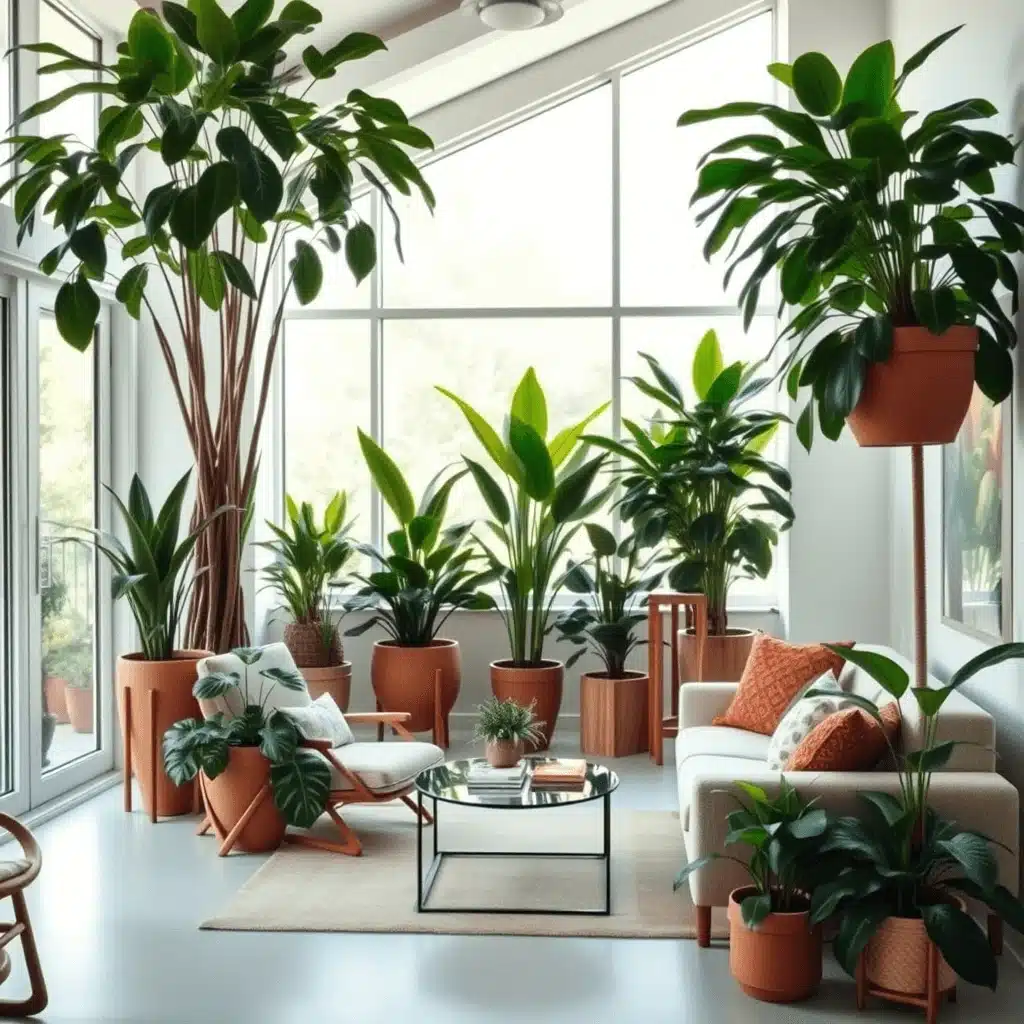Looking to add a touch of nature to your home but unsure where to start? Large indoor potted plants are a fantastic way to bring life and vibrancy into your living space. In this post, we’ll explore the benefits of these green giants, the equipment you’ll need, and expert tips to keep them thriving.
Table of Contents
Benefits of Large Indoor Potted Plants
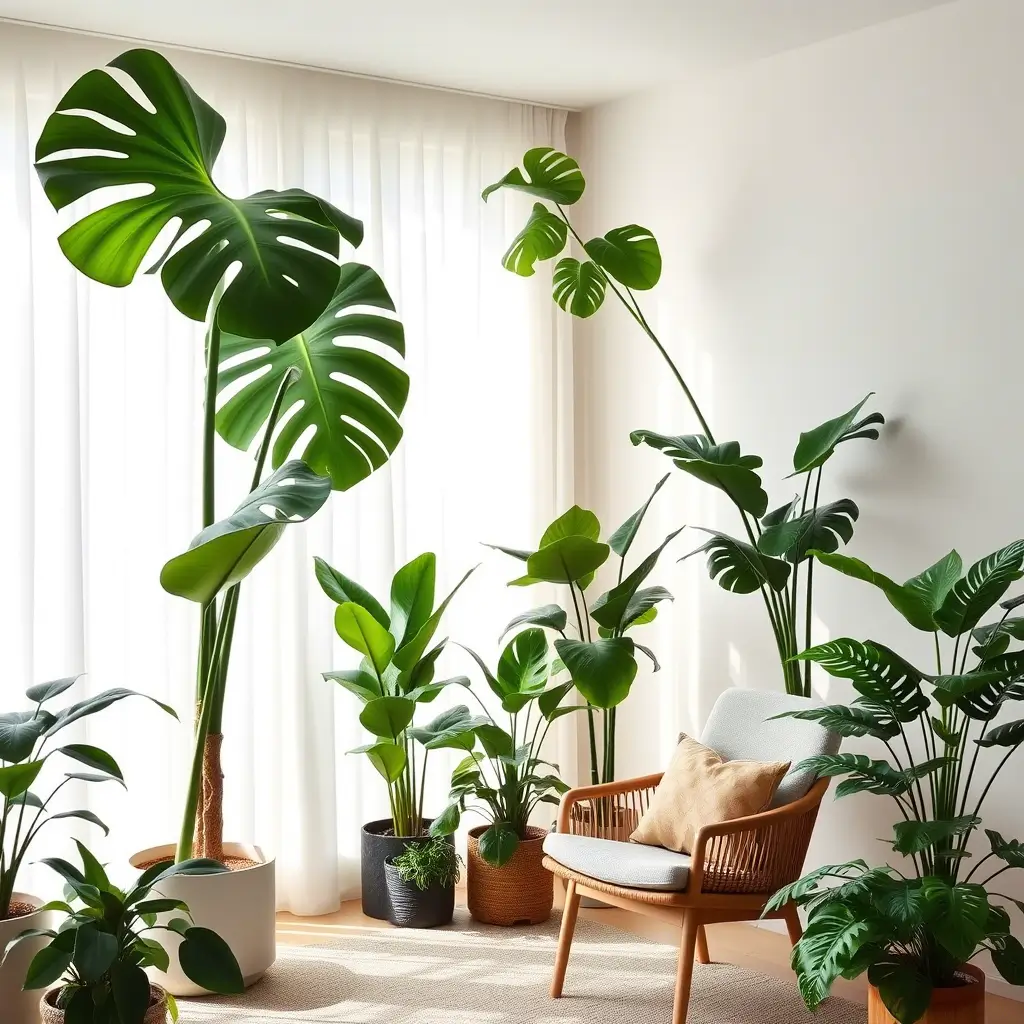

Aesthetic Appeal and Air Purification
Large indoor potted plants not only enhance the aesthetic appeal of your home but also improve air quality. Studies have shown that plants like the Fiddle Leaf Fig and Monstera can remove toxins from the air, making your home healthier and more inviting. The presence of greenery can transform a dull room into a lively, welcoming space. Imagine a corner of your living room adorned with a towering Rubber Plant, its glossy leaves catching the light and creating a natural focal point.
Image Alt Text: A lush Fiddle Leaf Fig in a stylish pot, enhancing a modern living room.
Stress Reduction and Well-being
Having greenery around can significantly reduce stress and boost your mood. Research indicates that interacting with plants can lower blood pressure and increase feelings of calmness. Imagine coming home to a serene environment where your large indoor plants create a calming oasis. The gentle rustle of leaves and the vibrant green hues can provide a much-needed escape from the hustle and bustle of daily life.
Image Alt Text: A peaceful corner with a Monstera plant, perfect for relaxation and meditation.
Environmental and Health Impacts
Beyond aesthetics and stress reduction, large indoor plants contribute to a healthier indoor environment. They increase humidity, which can be beneficial during dry winter months, and help reduce dust levels. Plants like the Peace Lily and Boston Fern are particularly effective at maintaining indoor air quality, making them excellent choices for allergy sufferers.
Image Alt Text: A Boston Fern in a decorative pot, adding greenery and improving air quality in a home office.
Planting Equipment Needed
To successfully grow large indoor potted plants, you’ll need the right tools:
- Pots and Containers: Choose pots with good drainage to prevent root rot. Consider the size and material of the pot, as these factors can affect plant health. Ceramic pots are stylish but can be heavy, while plastic pots are lightweight and versatile.
- Potting Soil: Use a high-quality potting mix suitable for indoor plants. A mix with added perlite or vermiculite can improve drainage and aeration.
- Watering Can / Spray Bottle: Ensure your plants receive the right amount of water. A long-spouted watering can help reach the base of large plants without spilling.
- Pruning Shears: Keep your plants healthy by trimming dead leaves. Regular pruning encourages new growth and helps maintain the plant’s shape.
- Grow Lights: Essential for rooms with low natural light. LED grow lights are energy-efficient and can be adjusted to provide the optimal light spectrum for plant growth.
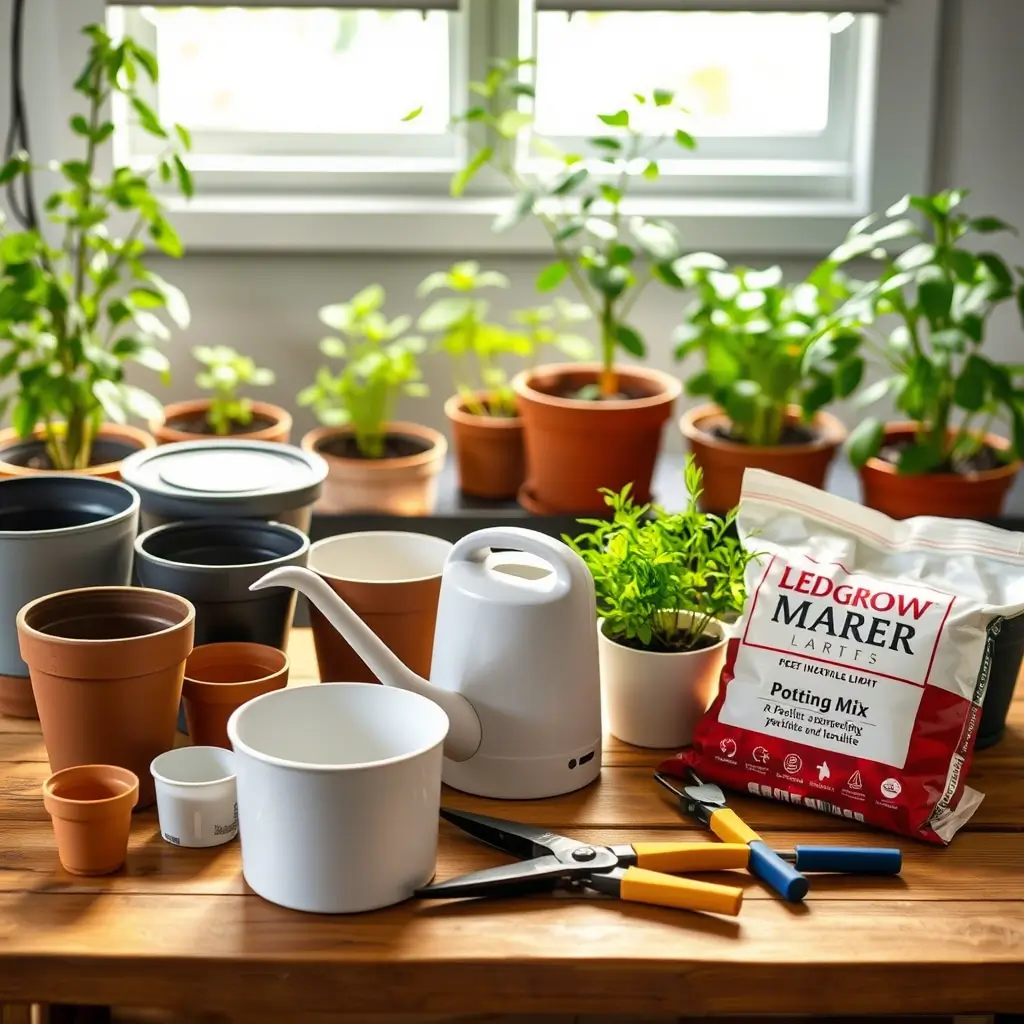

Step-by-Step Instructions
- Choose the Right Plant: Consider your space and light conditions. Large plants like the Bird of Paradise thrive in bright, indirect light, while the Snake Plant can tolerate lower light levels.
- Select a Suitable Pot: Ensure it’s large enough for growth and has drainage holes. A pot that is too small can restrict root growth, while one that is too large can lead to overwatering.
- Prepare the Soil: Fill the pot with potting mix, leaving room for the plant. Gently loosen the roots of the plant before placing it in the pot.
- Plant with Care: Gently place the plant in the pot, covering the roots with soil. Press the soil down lightly to eliminate air pockets.
- Water Thoroughly: Water until it drains from the bottom, then let it dry out before watering again. Overwatering is a common mistake, so ensure the top inch of soil is dry before the next watering.
Expert Tips for Plant Care
- Watering Schedule: Most large indoor plants prefer to dry out between waterings. Check the soil moisture regularly by sticking your finger about an inch into the soil. If it feels dry, it’s time to water.
- Light Requirements: Place your plants near windows but avoid direct sunlight, which can scorch leaves. Rotate your plants occasionally to ensure even growth.
- Pest Prevention: Regularly inspect your plants for pests and treat them promptly. Common indoor plant pests include spider mites and aphids. Use insecticidal soap or neem oil as a natural remedy.
Common Mistakes and How to Avoid Them
- Overwatering: This is the most common mistake. Ensure your pots have drainage holes and use a moisture meter to check soil moisture levels.
- Ignoring Light Needs: Each plant has specific light requirements. Research your plant’s needs and adjust its location accordingly.
- Neglecting Pruning: Regular pruning helps maintain plant health and encourages new growth. Remove dead or yellowing leaves promptly.
Large Indoor Potted Plant Recommendations
Fiddle Leaf Fig
- Light: Bright, indirect light
- Water: Allow the top inch of soil to dry out between waterings
- Soil: Well-draining potting mix
The Fiddle Leaf Fig is a popular choice for its large, glossy leaves and dramatic presence. It can grow up to 10 feet indoors, making it a striking addition to any room.
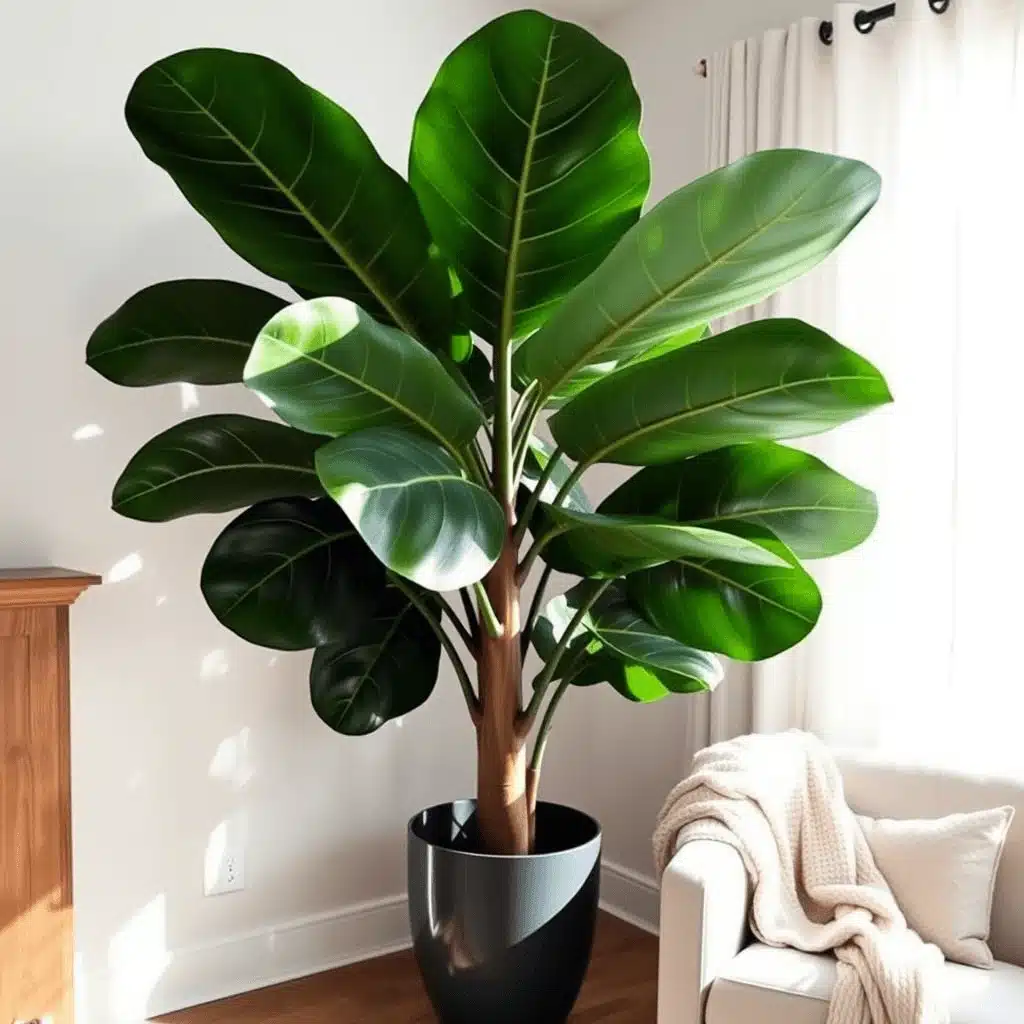

Monstera Deliciosa
- Light: Moderate to bright indirect light
- Water: Water when the top 2 inches of soil are dry
- Soil: Rich, well-draining soil
Known for its iconic split leaves, the Monstera Deliciosa adds a tropical touch to your home. It’s relatively easy to care for and can adapt to various light conditions.
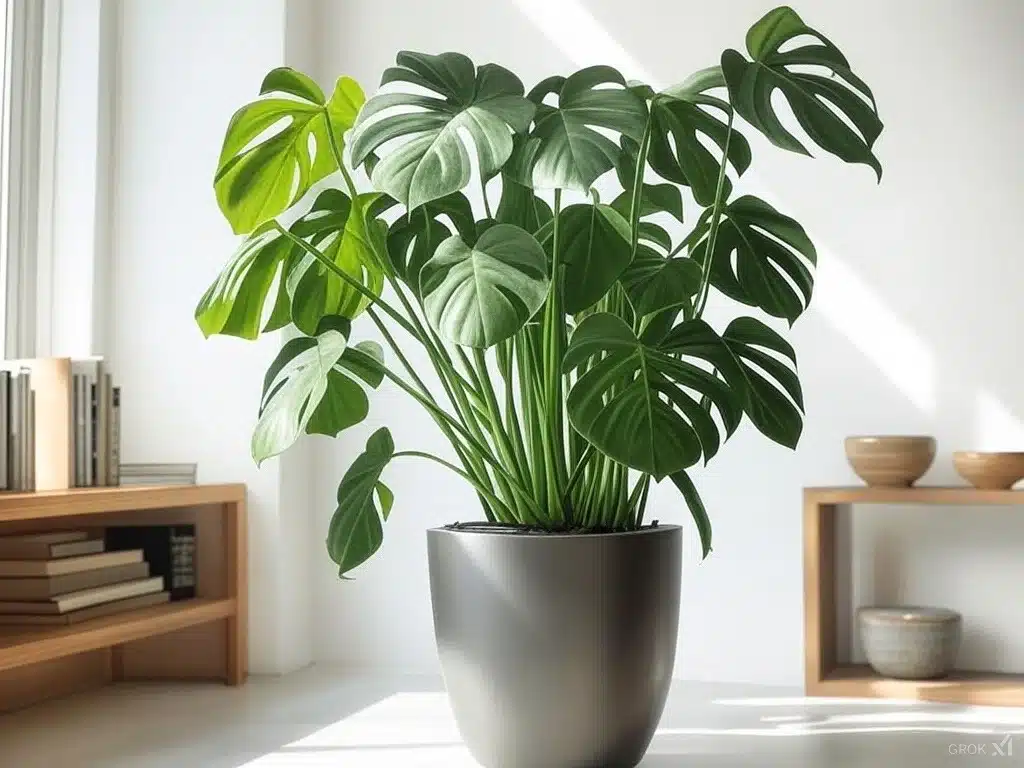

Rubber Plant
- Light: Bright, indirect light
- Water: Keep the soil moist but not soggy
- Soil: Well-draining potting mix
The Rubber Plant is known for its large, dark green leaves and can grow quite tall, making it perfect for filling empty corners.
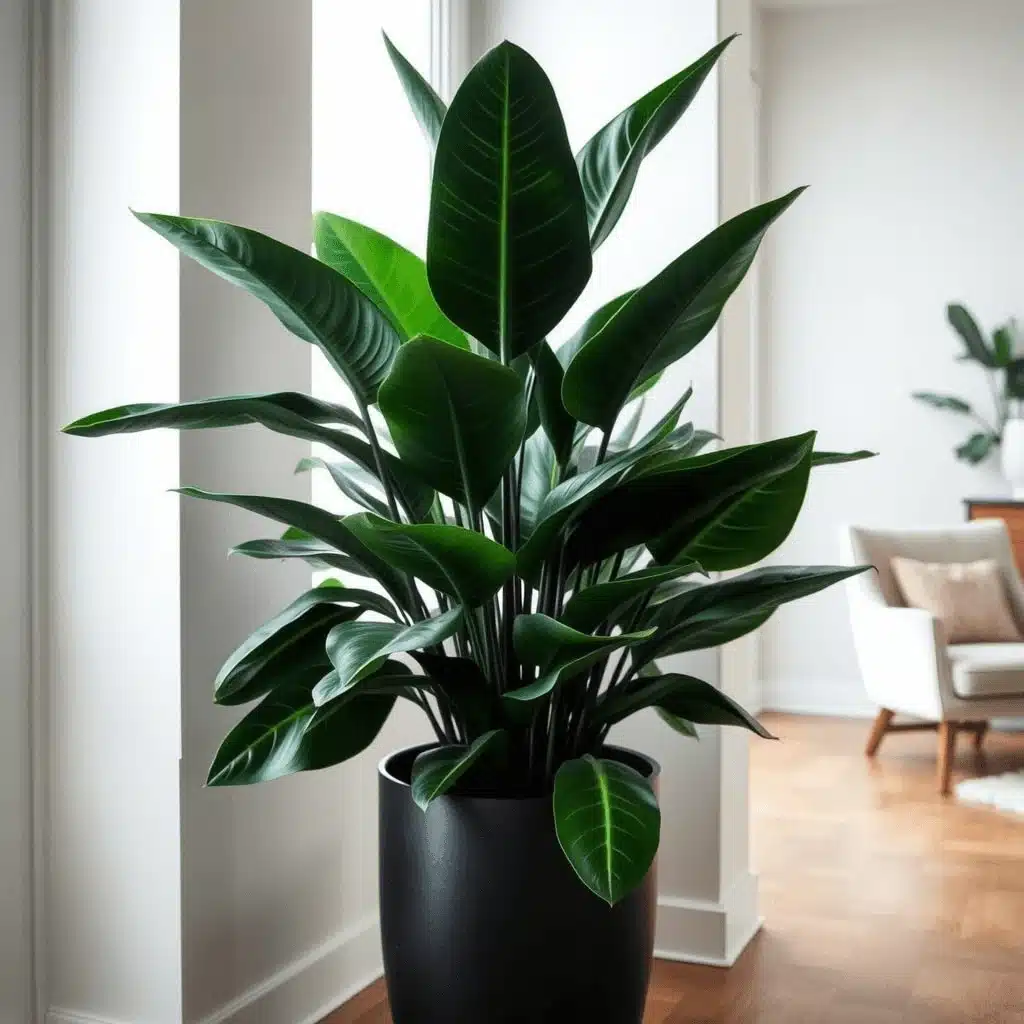

Styling Large Indoor Plants
Incorporate large indoor potted plants into your interior design by using plant stands or hanging pots. They can serve as focal points in living rooms or add a touch of nature to bedrooms and bathrooms. Consider grouping plants of varying heights for a dynamic display or using a single large plant as a statement piece.
Ideas for Specific Spaces
- Living Room: Use a large plant as a centerpiece or to frame a seating area.
- Bedroom: Place a plant near a window to create a calming atmosphere.
- Bathroom: Choose moisture-loving plants like the Boston Fern for a spa-like feel.
FAQs
What’s the best way to avoid overwatering my plants?
- Ensure your pots have drainage holes and only water when the top inch of soil is dry. Using a moisture meter can help you determine when your plant needs water 5. Additionally, it’s recommended to stop watering on a schedule and instead mind the seasons, as plants may require less water during colder months 1.
Can large indoor plants thrive in low light?
- Some plants, like the Snake Plant and ZZ Plant, can tolerate low light conditions. However, most large plants prefer bright, indirect light for optimal growth. If you’re focusing on transforming spaces with large indoor potted plants, consider adjusting light exposure first to suit the plant’s needs, which might also indirectly prevent issues such as overwatering 1.
Should I use specific types of pots to prevent overwatering?
- Yes, choosing terracotta pots can be beneficial since they allow the soil to dry out more quickly than plastic pots, helping to prevent root rot 2. Also, ensure that the pot has adequate drainage holes to let excess water escape 3.
How do I save an overwatered plant?
Laying paper towels or newspaper at the bottom of the pot can help wick away excess moisture. In some cases, using a turkey baster to remove standing water from the soil surface might also be helpful 6.
Who Should Be Careful or Skip Large Indoor Potted Plants
While large indoor plants are generally safe, certain individuals might need to exercise caution:
- Pet Owners: Some plants, like the Fiddle Leaf Fig, can be toxic to pets if ingested.
- Parents of Small Children: Ensure plants are out of reach to prevent accidental ingestion.
- Allergy Sufferers: Some plants may produce pollen or mold that can trigger allergies.
Conclusion
Large indoor potted plants are more than just decorative elements; they enhance your home’s air quality and provide a sense of tranquility. Whether you choose a Fiddle Leaf Fig or a Monstera, these plants are sure to make a statement.
Key Takeaways:
- Large indoor plants improve air quality and reduce stress.
- Essential tools include pots, soil, and grow lights.
- Follow care instructions for thriving plants.
Additional Resources
- 7 Beautiful Flower Decor and DIY Ideas to Add Color to Your Home This Spring
- Top 5 Ways to Gardening with AI: From Tradition to Innovation
- How You Can Turn Your Backyard Into a $10K/Month Business

